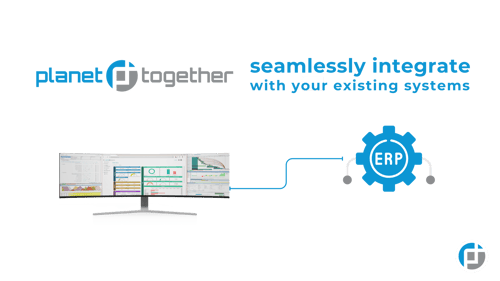
From Bottlenecks to Breakthroughs: Optimizing Pharmaceutical Resource Capacity with PlanetTogether
Why Resource Capacity Planning is Mission-Critical in Pharma
In pharmaceutical manufacturing, the stakes are high. Production delays can mean more than lost revenue—they can delay life-saving treatments, impact compliance, and threaten market competitiveness. For Production Planners, managing resource capacity is a daily challenge: balancing tight regulations, batch production requirements, complex BOMs, and fluctuating demand.
In this complex environment, Resource Capacity Planning (RCP) becomes essential—not just as a scheduling exercise but as a strategic function that directly impacts operational efficiency and compliance. With the help of advanced planning and scheduling (APS) platforms like PlanetTogether, especially when integrated with enterprise systems such as SAP, Oracle, Microsoft Dynamics, Kinaxis, or Aveva, planners can take a proactive, data-driven approach to capacity optimization.
Understanding Resource Capacity Planning in Pharmaceutical Contexts
Resource Capacity Planning is the process of aligning production requirements with available manufacturing resources—labor, machines, cleanrooms, equipment, and even specific formulations—over a specific time horizon. For pharmaceutical companies, this isn’t merely a matter of avoiding bottlenecks. It's about ensuring regulatory compliance, maintaining Good Manufacturing Practice (GMP), and meeting market timelines.
Key elements of RCP in pharmaceutical manufacturing include:
Finite scheduling of critical assets like reactors, filling lines, and packaging stations.
Batch-dependent capacity constraints, where equipment availability must align with formulation-specific requirements.
Labor skill matching, ensuring certified personnel are available for validation-sensitive tasks.
Material availability synchronization, especially for APIs and excipients under strict storage and handling conditions.
These complexities make it clear: spreadsheet planning or legacy MRP systems alone can’t keep up.
The Challenges of Manual or Fragmented Capacity Planning
Many pharmaceutical Production Planners still wrestle with siloed systems—separate databases for production, quality control, inventory, and human resources. Without a unified planning approach, issues like the following often arise:
Overloading of equipment due to misaligned production forecasts.
Underutilization of cleanrooms because of inaccurate visibility into maintenance schedules or batch changeovers.
Scheduling conflicts between concurrent product campaigns, especially for high-mix, low-volume operations.
Delayed product release cycles caused by unexpected downtime or uncoordinated QA/QC resource availability.
In such environments, reactive planning is the norm. This is where integrated APS solutions come in.

PlanetTogether + ERP/MES Integration: Enabling Intelligent Resource Planning
PlanetTogether APS is purpose-built to solve these challenges, enabling planners to take a proactive approach to capacity management. When integrated with ERP and MES systems like SAP, Oracle, Microsoft Dynamics, Kinaxis, or Aveva, it bridges data silos and brings real-time operational intelligence into the scheduling process.
Here’s how integration changes the game:
Real-Time Data Synchronization
Integration with SAP or Oracle ERP ensures that demand forecasts, purchase orders, BOMs, and routing data are always up to date. This eliminates the lag between plan creation and execution, allowing PlanetTogether to optimize schedules using the latest data.
Finite and Constrained Resource Scheduling
PlanetTogether uses constraint-based algorithms to schedule only within the actual limits of your resources. Cleanrooms, compounding tanks, lyophilizers, or packaging lines—every asset is modeled accurately, down to labor and sanitation intervals.
Cross-Functional Visibility
By integrating with MES systems like Aveva or Kinaxis, planners gain insight into real-time equipment status, batch progress, and quality checkpoints. This makes it easier to coordinate campaigns, avoid overbooking, and reduce time lost to cross-team miscommunications.
Labor and Certification Planning
PlanetTogether can factor in the availability of certified personnel and match them to the right tasks. Integration with Microsoft-based HR or training systems ensures compliance-sensitive operations are only scheduled when qualified technicians are on shift.
What-If Scenario Modeling
Production Planners can use simulation tools to assess how changes in demand, equipment failure, or delayed material deliveries would affect capacity. This empowers proactive planning and contingency strategies.

Key Benefits of Integrated Resource Capacity Planning
The shift from manual planning or fragmented systems to an integrated, APS-driven approach delivers tangible benefits across the production lifecycle:
Improved Throughput
Avoid bottlenecks by aligning task execution with available equipment and personnel. Increase the number of batches completed per week without compromising quality or compliance.
Enhanced Compliance
Automatically schedule only certified operators for GMP-sensitive operations. Maintain audit trails through synchronized data across all systems.
Reduced Downtime
Anticipate maintenance needs and avoid idle time through smarter sequencing and asset availability visibility from MES integration.
Agile Response to Demand Shifts
Quickly adapt to sudden order changes or recalls with what-if planning and automatic rescheduling that accounts for all dependent resources.
Increased OEE (Overall Equipment Effectiveness)
Maximize the utilization of high-capex assets by reducing changeovers and non-value-added time, a key KPI for plant performance.
Implementation Tips for Production Planners
If you're considering enhancing your resource capacity planning capabilities, keep these best practices in mind:
Map Your Critical Resources First
Start by identifying bottleneck machines, regulated clean areas, and limited human resources. This defines the foundation of your scheduling model.
Engage IT and Quality Early
Integration with ERP and MES platforms often involves compliance-sensitive data. Ensure all stakeholders align on data ownership, validation, and security.
Start with a Pilot Line
Begin with one product family or production line to validate the impact of APS. Gradually scale after confirming performance gains.
Use Dashboards and Alerts
Enable planners to act fast with real-time alerts and visual dashboards that highlight underutilized resources or upcoming constraints.
Train on Scenario Planning
Equip your team with skills to run what-if simulations. It’s the best way to future-proof your schedule in a highly dynamic environment.
Planning Capacity for Compliance, Agility, and Growth
For Production Planners in pharmaceutical manufacturing, resource capacity planning is no longer just a logistics task—it’s a strategic function that affects everything from regulatory readiness to patient access.
By leveraging a powerful APS solution like PlanetTogether, and ensuring seamless integration with ERP systems like SAP, Oracle, or Microsoft Dynamics, or MES platforms like Kinaxis and Aveva, planners can gain the agility, visibility, and control required to navigate today’s production challenges.
The result isn’t just a more efficient shop floor—it’s a smarter, more resilient pharmaceutical supply chain that can deliver the right products to the right patients at the right time.
Are you ready to elevate your resource planning strategy? Contact us today to learn more about how PlanetTogether APS can integrate with your existing ERP or MES system to revolutionize your pharmaceutical production planning.


